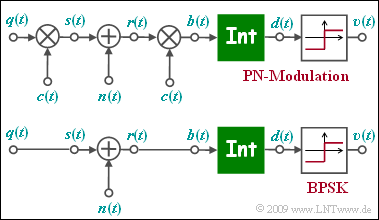Difference between revisions of "Aufgaben:Exercise 3.7: PN Modulation"
| Line 64: | Line 64: | ||
'''(1)''' Correct is the <u>solution 3</u>: | '''(1)''' Correct is the <u>solution 3</u>: | ||
| − | *This is an optimal receiver. | + | *This is an optimal receiver. |
| − | *Without noise, the signal $b(t)$ | + | *Without noise, the signal $b(t)$ is constantly equal to $+1$ or $-1$ within each bit. |
*From the equation given for the integrator | *From the equation given for the integrator | ||
:$$d (\nu T) = \frac{1}{T} \cdot \hspace{-0.03cm} \int_{(\nu -1 )T }^{\nu T} \hspace{-0.3cm} b (t )\hspace{0.1cm} {\rm d}t$$ | :$$d (\nu T) = \frac{1}{T} \cdot \hspace{-0.03cm} \int_{(\nu -1 )T }^{\nu T} \hspace{-0.3cm} b (t )\hspace{0.1cm} {\rm d}t$$ | ||
| − | :follows that $d(\nu T)$ can only take the values $±1$. | + | :follows that $d(\nu T)$ can only take the values $±1$. |
| − | '''(2)''' | + | '''(2)''' Correct is the <u>solution 3</u>. In the noise-free case ⇒ $n(t) = 0$, the twofold multiplication by $c(t) ∈ \{+1, -1\}$ ⇒ $c(t)^{2} = 1$ can be omitted, so that the upper model is identical to the lower model. |
| − | |||
'''(3)''' The <u>solution 1</u> is applicable: | '''(3)''' The <u>solution 1</u> is applicable: | ||
| − | *Since both models are identical in the noiseless case, only the noise signal has to be adjusted: $n'(t) = n(t) \cdot c(t)$. | + | *Since both models are identical in the noiseless case, only the noise signal has to be adjusted: $n'(t) = n(t) \cdot c(t)$. |
| − | *The solutions 2 and 3 | + | *The solutions 2 and 3 are not applicable: Integration must still be done via $T = J \cdot T_{c}$ $($not via $J \cdot T)$ and PN modulation does not reduce the AWGN noise. |
| − | '''(4)''' | + | '''(4)''' Correct is the <u>solution 3</u>: |
*The equation valid for BPSK and AWGN channel | *The equation valid for BPSK and AWGN channel | ||
:$$p_{\rm B} = {\rm Q} \left( \hspace{-0.05cm} \sqrt { \frac{2 \cdot E_{\rm B}}{N_{\rm 0}} } \hspace{0.05cm} \right )$$ | :$$p_{\rm B} = {\rm Q} \left( \hspace{-0.05cm} \sqrt { \frac{2 \cdot E_{\rm B}}{N_{\rm 0}} } \hspace{0.05cm} \right )$$ | ||
| − | :is therefore also applicable to PN modulation, independent of the spreading factor $J$ and the specific spreading sequence. | + | :is therefore also applicable to PN modulation, independent of the spreading factor $J$ and the specific spreading sequence. |
*For AWGN noise, the error probability is neither increased nor decreased by band spreading. | *For AWGN noise, the error probability is neither increased nor decreased by band spreading. | ||
Revision as of 14:11, 25 January 2021
The figure shows the equivalent block diagram of "PN modulation" or "Direct Sequence Spread Spectrum", abbreviated $\rm DS-SS$ in the equivalent low-pass range, where $n(t)$ stands for AWGN noise. Below, the low-pass model of binary phase modulation $\rm (BPSK)$ is sketched.
- The low-pass transmission signal $s(t)$ is equal to the rectangular source signal $q(t) ∈ \{+1, -1\}$ with rectangular duration $T$ only for reasons of uniformity.
- The function of the integrator can be written as follows:
- $$d (\nu T) = \frac{1}{T} \cdot \int_{(\nu -1 )T }^{\nu T} \hspace{-0.03cm} b (t )\hspace{0.1cm} {\rm d}t \hspace{0.05cm}.$$
- The two models differ in the multiplication by the $±1$ spreading signal $c(t)$ at the transmitter and the receiver. Of the signal $c(t)$ only the spread degree $J$ is known.
- The specification of the specific spreading sequence (M sequence or Walsh function) is not important for the solution of this task.
It has to be examined whether the lower BPSK model can also be applied with PN modulation and whether the BPSK error probability
- $$p_{\rm B} = {\rm Q} \left( \hspace{-0.05cm} \sqrt { {2 \cdot E_{\rm B}}/{N_{\rm 0}} } \hspace{0.05cm} \right )$$
is also valid for PN modulation, or how the given equation should be modified.
Notes:
- This task refers to the chapter Characteristics of UMTS.
- The CDMA method used for UMTS is also known as "PN modulation".
- The nomenclature used in this task is partly based on the page Direct-sequence spread spectrum modulation of the book "Modulation Methods".
Questionnaire
Solution
(1) Correct is the solution 3:
- This is an optimal receiver.
- Without noise, the signal $b(t)$ is constantly equal to $+1$ or $-1$ within each bit.
- From the equation given for the integrator
- $$d (\nu T) = \frac{1}{T} \cdot \hspace{-0.03cm} \int_{(\nu -1 )T }^{\nu T} \hspace{-0.3cm} b (t )\hspace{0.1cm} {\rm d}t$$
- follows that $d(\nu T)$ can only take the values $±1$.
(2) Correct is the solution 3. In the noise-free case ⇒ $n(t) = 0$, the twofold multiplication by $c(t) ∈ \{+1, -1\}$ ⇒ $c(t)^{2} = 1$ can be omitted, so that the upper model is identical to the lower model.
(3) The solution 1 is applicable:
- Since both models are identical in the noiseless case, only the noise signal has to be adjusted: $n'(t) = n(t) \cdot c(t)$.
- The solutions 2 and 3 are not applicable: Integration must still be done via $T = J \cdot T_{c}$ $($not via $J \cdot T)$ and PN modulation does not reduce the AWGN noise.
(4) Correct is the solution 3:
- The equation valid for BPSK and AWGN channel
- $$p_{\rm B} = {\rm Q} \left( \hspace{-0.05cm} \sqrt { \frac{2 \cdot E_{\rm B}}{N_{\rm 0}} } \hspace{0.05cm} \right )$$
- is therefore also applicable to PN modulation, independent of the spreading factor $J$ and the specific spreading sequence.
- For AWGN noise, the error probability is neither increased nor decreased by band spreading.
